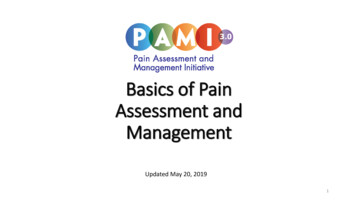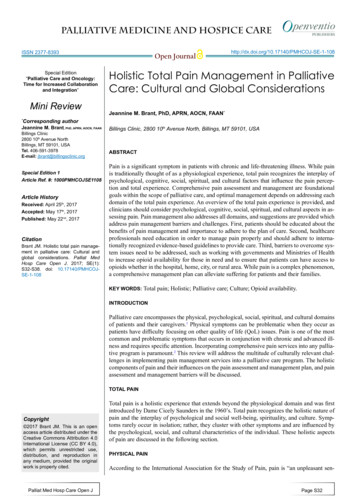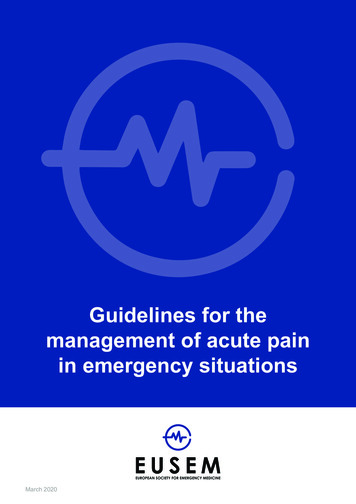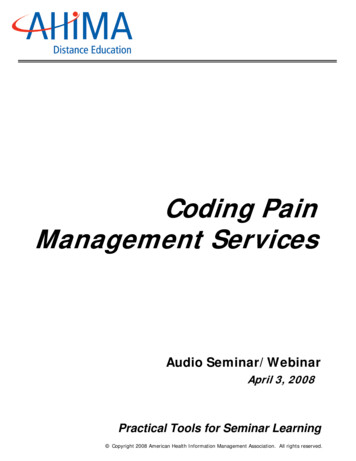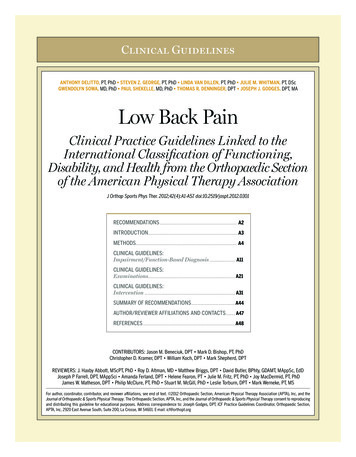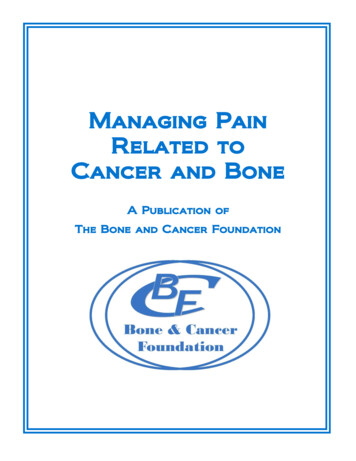
Transcription
Managing PainRelated toCancer and BoneA Publication ofThe Bone and Cancer Foundation
Managing Pain Related to Cancer and BoneIntroductionThis booklet provides information on pain management for cancer patients with bonecomplications. The information includes methods doctors use to monitor and measure pain,treatments for bone pain, and information on various medical specialists who assist patients withpain management.1. Q. How can pain be described or measured?A: Health professionals may use several different methods to determine how much pain thepatient is feeling. Patients should speak up and tell their doctor about their bone pain to ensurethat the pain is treated properly.Some of the methods used to measure pain include a zero to ten (0-10) scale, the Brief PainInventory, which asks a series of questions, a visual analog scale, which uses the numbers 0 – 10to represent pain, with 0 being no pain and 10 being the worst and the Faces Pain Rating Scale,where expressive faces are used to indicate how the patient is feeling. The FACES scale is oftenused in children. The use of the 0-10 number helps the doctor and patient communicate aboutthe effectiveness of treatments for their bone pain.Wong-Baker FACES Pain Rating ScaleFrom Hockenberry MJ, Wilson D: Wong’s essentials of pediatric nursing, ed. 8, St. Louis, 2009, Mosby. Used withpermission. Copyright Mosby2. Q. How does pain related to bone metastases feel?A: This type of bone pain may be felt in different ways. Many patients who have pain related tobone metastasis describe the pain as dull and aching. Other patients experience short or shootingpains from the body through the bones in the arms and legs. The pain may get worse at night orwith bed rest, or the pain may get worse with activity or movement, depending on which bone orbones are affected. If any bone pain worsens suddenly, or a new site of pain develops, thepatient should contact his or her doctor as a fracture may have occurred or the cancer may havespread to another bone.1
3. Q. How is bone pain treated?A: Many treatments are available to lessen pain from bone metastases. These treatments includedrug therapies, medical treatments and procedures, surgery, non-drug therapies and supportivecare. The treatments used may depend upon the location and the severity of the bone pain, aswell as other factors. Doctors and other medical professionals involved in patient care maysuggest a combination of therapies to help the patient manage pain and feel better.4. Q. What are some medical treatments used to treat bone pain?A: There are many different medications and treatments that may be used to treat bone pain,based on the severity of the pain, and the bone or bones involved as well as other healthconsiderations. They include:Pain medications: Drugs including Acetaminophen, Nonsteroidal Anti- inflammatory Drugs(NSAIDs), Opioids, and other medications.Radiopharmaceuticals: Drugs that use radiation to treat bone metastasis pain. They areadministered by IV (intravenous infusion).Bisphosphonates: Drugs used to prevent breakdown of bone. They are also used to treat Paget’sdisease, osteoporosis and other benign bone diseases.Denosumab: A drug that prevents bone breakdown by inhibiting RANKL, a protein thatactivates osteoclasts the cells that are involved in bone breakdown.Calcitonin: A synthetic hormone, given as an injection with pain medications such as morphine.In certain cases, Calcitonin is also used to treat Paget’s disease, osteoporosis and other benignbone diseases.Adjuvant Analgesics: These are so-called “dual use” medications which help to alleviate pain inaddition to their primary use. These may include drugs that are antidepressants, corticosteroids,local anesthetic medications, anticonvulsants and muscle relaxers.2
Medications commonly used to treat pain for cancer in the bone *Type of treatmentDrug typeExamples of Name/brandsPain oxenTylenolOpioidsTylenol with Codeine, Percocet ,Percodan , Vicodin , Morphine,Dilaudid Metastron , Quadramet RadiopharmaceuticalsBisphosphonatesRANKL InhibitorCalcitoninAdjuvant AnalgesicsAll brandsMotrin , Advil , etc.Naprosyn , Anaprox , Aleve ,strontium-89samarium-153Zoledronic acidPamidronateDenosumabSynthetic hormoneAntidepressantsCorticosteroidsAnesthesia drugsAnticonvulsantsMuscle relaxersZometa Aredia Xgeva Miacalcin Elavil , Celexa , Cymbalta Prednisone, DexamethasoneLidoderm Neurotin , Lyrica , Trileptal Flexeril , Skelaxin * This chart is by no means comprehensive nor is it an endorsement of any drug or brand name. There aremany other effective medications that doctors may prescribe to treat pain from cancer in the bone.Generic versions of many of the drugs listed in this chart are also available.5. Q. What are some other treatments that may be used to lessen bone pain?A: There are several other treatments that are used to lessen bone pain. These include externalbeam radiation therapy, vertebroplasty, kyphoplasty, radiofrequency ablation, cyberknifetreatment, and implanted pain pump therapy.External Beam radiation therapy uses a machine to target high-energy beams at cancer cells totreat the cancer or lessen the pain of bone metastasis.Vertebroplasty and Kyphoplasty are minimally invasive treatments involving the injection ofbone cement into a collapsed/fractured or tumor involved vertebra to stabilize the fracture andreduce pain.Radiofrequency ablation is used to treat cancer in multiple bone sites. A small needle is used totransmit an electric current into the tumor to destroy the tumor and relieve pain.Cyberknife treatment directs highly focused radiation beams to tumors to destroy them andrelieve pain.3
An implanted pain pump infuses pain medication into the spine in cases of pain resistant toother treatments.6. Q. When is surgery required to lessen bone pain?A: The need for surgery is based on the severity of the cancer that has spread to the bone and thecondition of the bone affected by the cancer. Bones affected by cancer that are significantlyweakened and at risk of developing a pathologic fracture are often stabilized through surgery.Sometimes a bone that has fractured or that presses on the spinal cord may also require surgery.More specific information can be found in the Bone and Cancer Foundation booklet, SurgicalManagement of Cancer that Spreads to the Bone.7. Q. What other therapies may be useful to patients experiencing bone pain?A: Non-drug therapies like rehabilitation programs, physical therapy or exercise may beprescribed by a doctor to ease pain and make it easier to resume normal activities. Any exerciseor physical therapy depends on the patient’s condition, including which bones are affected by themetastasis. Exercise or physical therapy should never be undertaken without approval of thedoctor managing the overall treatment. (Please refer to the Bone and Cancer Foundation booklet,Physical Therapy and Other Rehabilitation Therapies for Patients with Cancer and BoneInvolvement)Other supportive care may include psychological therapies and strategies, biofeedback, holistictreatments such as massage or relaxation, acupuncture, acupressure, music therapy and guidedimagery, among others. These therapies should not replace medical or surgical treatments, butmay be used in addition to those treatments to help manage pain and help the patient feel better.8. Q. Which medical specialists are helpful in managing pain?A: Some of the medical specialists who manage patient’s care include:Oncologists – doctors who specialize in treating cancer.Radiation oncologists – doctors who use radiation to treat cancer.Neurologists/Neurosurgeons – doctors who treat illnesses and injuries related to the brain,spine and nervous system.Orthopedic surgeons – doctors trained to deal with problems that develop in the bones,joints, and ligaments of the human body.Physical medicine doctors or Physiatrists – doctors who devise rehabilitation plans torestore maximum physical function lost through injury, illness or disabling conditions.Pain specialists or palliative care specialists – doctors who are experts at helping controlsevere pain symptoms including those related to metastatic cancer.4
Oncology nurses – nurses who are experienced in treating cancer patients.Orthopedic nurses – nurses who work with orthopedic doctors.Physical Therapists – medical professionals who help individuals who have been injured orphysically affected by illness to recover or improve function.Mental health professionals – psychologists, psychiatrists, social workers and othermedical professionals who help patients cope with the stress caused by pain or treatments.5
The mission of The Bone and Cancer Foundation is to:Provide information to cancer patients and family members on thecauses and current treatment of cancer that involves the bone;Provide information and serve as a resource for physicians, nursesand other health professionals regarding the managementof cancer that spreads to the bone.The Bone and Cancer FoundationWebsite: www.boneandcancerfoundation.orgThe Bone and Cancer Foundation is a program ofThe Paget Foundation for Paget’s Disease of Bone and Related Disorders,an Internal Revenue Service (IRS) designated 501c3 organization.A copy of the Foundation’s annual report is available by writing to theFoundation office or the Office of the Attorney General, State of New York,Charities Bureau, 120 Broadway, New York, NY 10271Copyright, Bone and Cancer Foundation, 2011
An implanted pain pump infuses pain medication into the spine in cases of pain resistant to other treatments. 6. Q. When is surgery required to lessen bone pain? A: The need for surgery is based on the severity of the cancer that has spread to the bone and the condition of the bone affected by the cancer. Bones affected by cancer that are .



